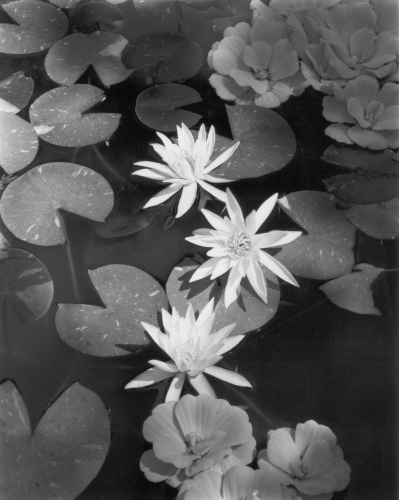



 |
Water Lilies
Central Image
We have enjoyed a cool summer in Ohio, bringing with
it an abundance of lustrous days at Mansfield's Kingwood Center, a large
estate full of rambling, formal gardens, greenhouses, and reflecting ponds.
The water lilies in one particular pond first arrested my attention on
Sunday, July 26th. In early afternoon, with gentle light filtering high from
the right through trees, the "central" image appeared, just as you see it !
A glowing white bloom was in the upper right of the composition I
visualized, a purplish bloom floated in the lower left, and a white feather
in the lower right. The surface of the pond was telling a story of its own,
and the lower halves of the lily plants were "suggestions" just below the
surface. I incident metered the scene, taking the high reading in full
light, with meter cheated a bit away from the sky to raise the value of the
white bloom. There was no convenient shadow, so I took the low reading in my
own shadow, standing directly in front of the visualized image. I used a 210
mm lens on my 4x5 camera, composed the image, then tilted the back to secure
focus across the plane of the water. This movement produces a slight looming
effect in the feather and near bloom, and effect I find pleasing. It was a
still day, so I stopped down to f45 to ensure tack sharp focus; ExpoDev
calculated a 1/4 second exposure. I considered use of a polarizing filter,
but it would have reduced the interesting variations on the water's surface.
I chose to print this image on Kodak Fine Art fiber-based paper with an ES
of 1.10 for "grade 2" and to match it with Kodak 400 Tmax film, developed in
DDX 1+6, to an average gradient of .64. The close up image was somewhat
flat, I metered an SBR of about 6.0. The resulting expansion in development
produces this image on the selected paper grade with few manipulations save
a bit of burning of the edges, and a final burn of the lower glare on the
lower right-hand water surface. Distance to the center of the image was
about 57" from the lensboard; ExpoDev included an bellows extension factor
of 1.37.
Left Image
Returning to Kingwood on August 17th, hoping for skyscapes but finding
that all the clouds had vanished by the time I arrived, I had a look at the
water lily pond in mid-afternoon. This three-bloom arrangement was glowing
in a shaft of light that I feared would soon disappear! I scrambled to set
up, compose, focus and meter. The SBR of this scene was 8.8, the result of
the "spotlight" effect and few reflections on the leaves surrounding the
blooms (I metered the high value in the light shaft, with meter cheated
slightly away from the sky, the low in the shadow of a nearby grassy watery
plant.) The surface of the water was quite even, with no disturbing glare or
reflections, so I quickly decided against a polarizing filter. A gusty wind
introduced a new challenge on this occasion, so I stopped down minimally
(again using the 210mm lens), watching the ground glass until the middle
bloom was in sharp focus; I obtained satisfactory focus at f 8. ExpoDev
recommended f 8 1/2 at 1/60th of a second, an ideal combination for the
conditions. I again chose Kodak FA paper, grade 2, and 400 Tmax film. This
negative is a bit trickier to print, requiring that the leaf clusters in the
upper right hand and center portions of the image be held back, along with
the leaves in the lower left hand corner. The edges are then burned to frame
the image.
Right Image
This image, taken from the north side of the pond (the first two were
taken from the west side), was made at about 2:30 PM, and was back lighted,
producing delicious reflections on the leaves, specular highlights where the
leaf edges intersected the water's surface, and a challenging metering
situation! The image I envisioned, farther out in the pond than the previous
compositions, required the use of a 305 mm lens. The high incident reading
was taken in full sun, with meter cheated toward the sky to hold the high
values in the leaves. Not finding a suitable shadow simulation, I noticed my
camera bag on the ground to my left, held up its cover, and took the reading
about halfway into the shadow (my bag is dark grey and serves well for this
purpose!) The resultant SBR was 8.5 and, with my choice of materials,
ExpoDev called for an exposure of 1.82 seconds at f 45. I had to wait for
mild breezes to abate before opening the shutter. ExpoDev contains a
remarkably handy timer feature that gives a 3-second countdown, allowing
plenty of time to hit the timer then trip the shutter release. The negative
is quite easy to print on the targeted paper grade. I hold back the bloom a
bit to raise its relative value, then give framing edge burns. This image is
enlarged a bit more than the first two, to allow for cropping of a bright
intrusion on the left margin.
I hope that the reader notices the relative ease with which each scene was
metered. It certainly would have been possible, given the close-up
conditions, to use a spot meter and a zone approach, but I would have taken
more time to do so, probably scanning the image for luminance "spreads" and
then trying to read small, selected values. Incident metering allowed me to
operate quickly, confident I was locating the ends of the useful image scale
and recording all that lay between in a desirable distribution on my
selected film.
Water Lily Triptych center Water Lily Triptych right

|


![]()